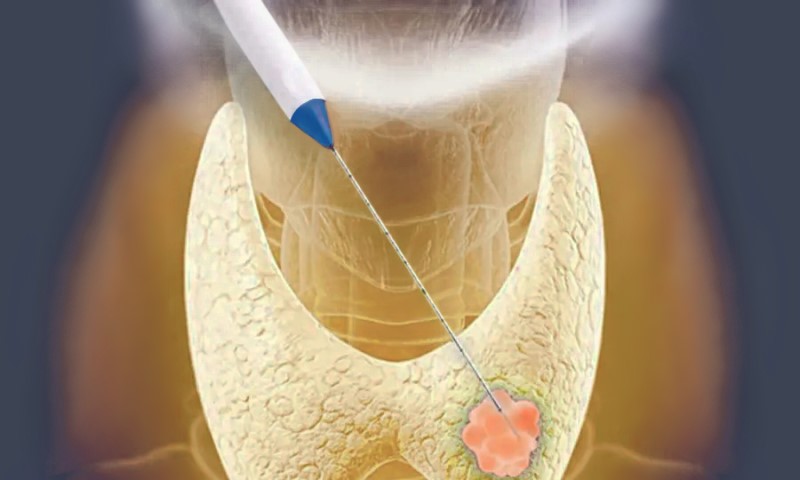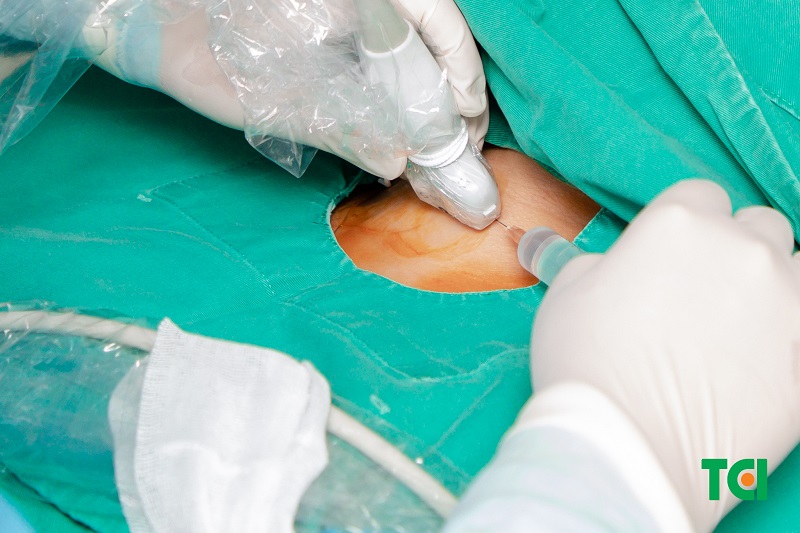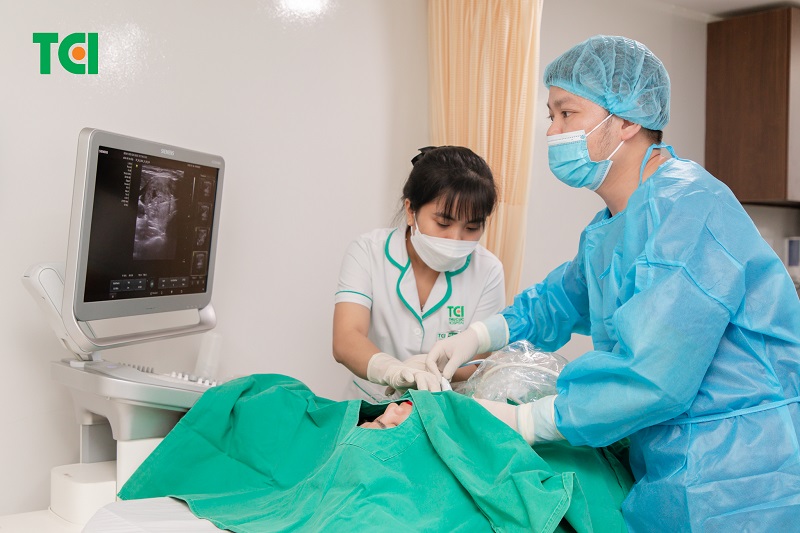Radiofrequency ablation (RFA) for thyroid nodules is an advanced method used in the treatment of benign thyroid nodules. This technique offers effectiveness in removing nodules while ensuring safety and cosmetic outcomes.
1. Understanding Radiofrequency Ablation (RFA) for Thyroid Nodules
Radiofrequency ablation involves using heat generated by high-frequency waves to destroy thyroid nodules. This procedure is performed by directing a small needle directly into the nodule (through the skin) under ultrasound guidance. The heat generated from the high-frequency alternating current of the ablation device dries out the targeted tissue, causing dehydration in the cells and gradually leading to necrosis and disappearance of the nodule. Continuous cooling of the needle shaft is ensured through water-cooling technology, thus preventing damage to surrounding healthy tissues.
Previously, surgery was the standard method for treating symptomatic thyroid nodules. However, this approach could lead to complications such as bleeding, injury to the recurrent laryngeal nerve, postoperative hypothyroidism, and unsightly scars. With minimally invasive ablation techniques like radiofrequency ablation, some patients may be recommended this approach instead of traditional surgery.

The required temperature for radiofrequency ablation of thyroid nodules needs to be maintained between 60-100 degrees Celsius.
2. Advantages and Disadvantages of RFA for Thyroid Nodules
Radiofrequency ablation offers several advantages over conventional surgery:
– Minimal invasion, no pain, and no long scars on the neck, ensuring cosmetic outcomes.
– High treatment efficacy, reducing nodule size and symptoms while preserving thyroid function.
– No general anesthesia required, only local anesthesia, avoiding complications associated with general anesthesia.
– Short procedure time (30-45 minutes), no hospitalization required, minimizing bed occupancy and post-treatment care.
– Reduced risks commonly associated with thyroid surgery, such as recurrent laryngeal nerve injury, shock, and hoarseness.
– Patients can resume normal activities without restriction soon after the procedure.
– Particularly, patients do not need hormone replacement therapy after treatment, as required with thyroidectomy.
Despite these advantages, radiofrequency ablation may have limitations, including high procedural costs and limited availability of the technology in all healthcare facilities. Therefore, not all patients may have access to this treatment option.

Radiofrequency ablation for thyroid nodules stands out for its painless treatment and high cosmetic outcomes.
3. Indications for Radiofrequency Ablation (RFA) for Thyroid Nodules
Not all patients with thyroid nodules are suitable candidates for radiofrequency ablation. Besides cost and equipment constraints, this method is only indicated in specific cases, including:
– Prominent nodules in the neck causing cosmetic concerns.
– Large nodules compressing the larynx or esophagus, leading to swallowing difficulties, choking, or discomfort.
– Hyperfunctioning thyroid nodules causing hyperthyroidism.
– Early-stage well-differentiated thyroid cancer without distant metastasis.
– Recurrent or residual thyroid cancer after surgery, or local recurrence after surgery.
Although there are no absolute contraindications, radiofrequency ablation is not recommended for pregnant women, individuals with severe cardiovascular diseases, or those with paralysis of the recurrent laryngeal nerve.
4. Procedure Overview
Radiofrequency ablation for thyroid nodules typically involves three main steps:
4.1 Pre-ablation preparation
Clinical examination and thyroid function tests are essential before the procedure. After counseling with the physician and understanding the pros and cons of the method, patients sign a consent form to undergo the ablation.
4.2 Ablation procedure
Initially, ultrasound is used to accurately locate the nodule and determine its size and volume. Fine-needle aspiration is performed to obtain tissue samples for histopathological examination, aiding in the diagnosis of nodule characteristics. If radiofrequency ablation is indicated, the physician performs a sterile technique, administers local anesthesia to the patient’s neck, and conducts the ablation. With ultrasound guidance and the thermal effect of the ablation device, the thyroid nodules gradually shrink and disappear.
4.3 Post-procedure monitoring
After the ablation, patients rest and are monitored in the hospital for 30-60 minutes before discharge. Due to minimal invasiveness, patients do not require strict bed rest and can quickly return to their daily activities.
Typically, it takes 9-12 months for thyroid nodules to significantly reduce in size or disappear. However, if the desired outcome is not achieved after the first treatment, patients can undergo repeat ablation sessions without concerns about previous surgical scars.

TCI Thu Cuc is the medical facility that specializes in performing radiofrequency ablation for thyroid nodules for patient
5. Considerations After Radiofrequency Ablation (RFA)
Although radiofrequency ablation is an effective and safe treatment option for thyroid nodules, it takes time to fully assess its accuracy. Therefore, patients should adhere to follow-up appointments (typically every 1, 3, 6, or 12 months, as recommended by the physician). If treatment goals are met, and laboratory parameters return to normal, follow-up visits may be spaced further apart.
Regular thyroid monitoring is necessary at least once a year for five consecutive years after ablation. This ensures early detection of any recurrence or new nodules, allowing timely intervention.
In conclusion, radiofrequency ablation for thyroid nodules offers numerous benefits, providing patients with a safe and minimally invasive alternative to surgery. However, thorough evaluation and follow-up are essential to ensure optimal outcomes and long-term health.








